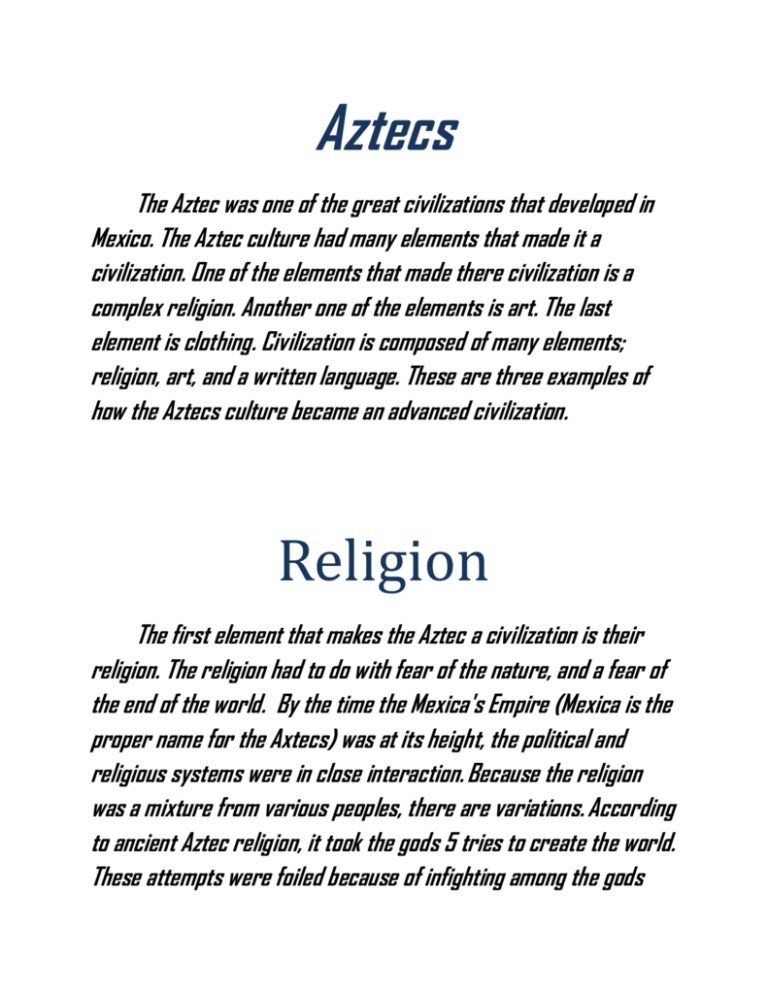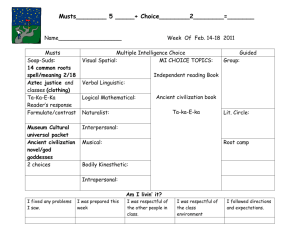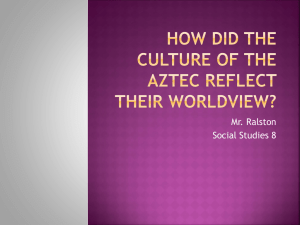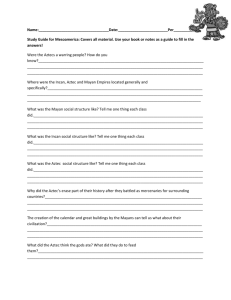File - Aaron Mullins
advertisement

Aztecs The Aztec was one of the great civilizations that developed in Mexico. The Aztec culture had many elements that made it a civilization. One of the elements that made there civilization is a complex religion. Another one of the elements is art. The last element is clothing. Civilization is composed of many elements; religion, art, and a written language. These are three examples of how the Aztecs culture became an advanced civilization. Religion The first element that makes the Aztec a civilization is their religion. The religion had to do with fear of the nature, and a fear of the end of the world. By the time the Mexica's Empire (Mexica is the proper name for the Axtecs) was at its height, the political and religious systems were in close interaction. Because the religion was a mixture from various peoples, there are variations. According to ancient Aztec religion, it took the gods 5 tries to create the world. These attempts were foiled because of infighting among the gods themselves. Each time a creator-god would take a turn being the sun. Finally the gods had a council, and decided one of them would have to sacrifice himself to be the new sun. Nanauatl, a lowly, humble god became the sun, but there was a problem - he wasn't moving. The gods realized that they all must sacrifice themselves so that humans could live. The god Ehecatl sacrificed the others, and a mighty wind arose to move the sun at last. Math Art in the Aztec empire, like its culture and religion, came from a long history - a history of many different tribes. Techniques and themes in Aztec art were influenced by hundreds, perhaps thousands of years of artistry in this part of the world. The common people were not generally allowed to even own works of art. If you were creating and selling art, you may be an exception, but some of the art would have to go to the upper classes. They were the ones that generally were the keepers of the precious objects in the empire. Neither did the civilization keep all its art to itself. Ancient Aztec art was traded, and much of the materials used were imported from other peoples. There was a rich variety of art in the empire. Richly colored clothing, architecture, ceremonial knives, head dresses many things were adorned with jewels and feathers. It is said that the emperor never wore the same clothes twice. His head piece that supposedly belonged to Emperor Montezuma II is a splash of bright green feathers, embroidered with gold and blue. Noble families had ear pieces, bracelets and necklaces. Mosaics are very common in ancient Aztec art. Masks would be covered in turquoise, or shells. Ancient Aztec art was actually very lifelike. Many of their statues of people, as well as animals, look amazingly realistic. They also show age, and a great deal of expression. The art looks alive but then again, much of it is about death itself. It again reflects the people's passion to avoid death and disaster, and then to conquer even that if it came. Clothing Ancient Aztec clothing, that is, the clothing worn by the tribes that made up the Aztec empire (such as the Mexica people), was rich in variety. Aztec clothing was generally loose fitting and did not completely cover the body. When the Spanish arrived in Mexico, the people were surprised to see them in their full armor, with only their faces exposed. Aztec clothes were generally made of cotton (which was imported) or ayate fiber, made from the Maguey Cactus (also called the Century Plant or American Aloe). Women would weave the fibers into clothing, task girls were taught as young teenagers. Because of their vast trading network, the Aztecs were able to make use of a beautiful array of dyes, creating the brilliant colors still seen in Mexico today. Slaves would only wear a simple loincloth. The loincloth, also worn by common people, was made from a long strip of cloth tied in front. If the man had a little higher social standing, it might be embroidered or have fringes on the two ends. The men would also wear a cloak made from a triangular cloth known as a tilmatli or tilma. It could be used like an apron to carry things, or worn as a cloak. Of course the noble class and religious leaders would wear clothing that was much more adorned, though still tilmas and loincloths and skirts would be worn. There would be symbols of their particular affiliation on the clothing or in a head dress. The more prestigious clothing became brightly colored. Gold was often used in clothing, and pendants, feathers, furs, and other forms of decoration were used. Jewelry such as necklaces, earrings and bracelets were also worn by the upper classes. Like tribes still in Mesoamerica today, some wore "ear spools". Of course, for certain rituals costumes were worn which became even more elaborate. Aztec masks were used for rituals, representing various Aztec gods. The military had their own costumes; based on what military group they belonged to - the eagle or the jaguar, for example. Even for the Aztec warrior, there was a hierarchy that was reflected by how adorned their costumes were. Those who were war heroes were allowed more jewels and more stunning clothing. The ancient Aztec clothing of the warrior offered some protection, and their head dresses also served as helmets. Some of the chiefs even wore a layer of gold. Warriors carried a simple decorated shield. Conclusion The Aztec arrived in the Valley of Mexico in the early 1300s and became a powerful, but feared civilization. The savage Aztec religion would not be acceptable in today’s society, but it demonstrated complex, organized beliefs. Because the Aztec reached a level where specialization was possible, Aztec artist and craftsmen created remarkable pieces of art. Also the everyday necessities and luxury items vital to a civilization were made possible by the Aztec traders. Even though the Aztec would be considered barbaric today, their accomplishments in religion, arts/crafts, and clothing make them one of most advanced civilizations to arise in Mesoamerica.




